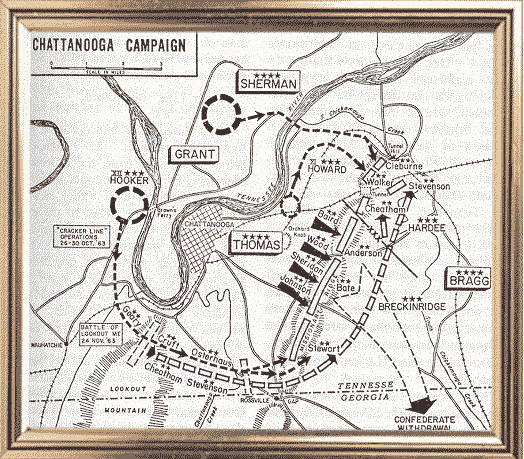Chattanooga Campaign
In 1863 the Confederate forces in Tennessee were largely on the defensive. The North was intent on taking the city of Chattanooga for the following reasons:
- Chattanooga was a major regional railroad center; various lines came into the area, then headed south into Georgia and Alabama where the Union anticipated future military action
- Chattanooga and the heights outside of town commanded an important point on the Tennessee River, a major artery that flowed in a U-shaped course from eastern Tennessee down to Chattanooga and then northward to the Ohio River
- Control of the city and river would secure eastern Tennessee, home to a large population of pro-Unionists.
On August 16, 1863, General William Rosencrans led the Union Army of the Cumberland against Chattanooga. The confederates evacuated Chattanooga on September 9, and union troops subsequently occupied it. Reinforcements drawn largely from Longstreet`s Corps from Virginia were brought to the area and under the generalship of Braxton Bragg defeated the union forces at the
Battle of Chickamauga. Rosencrans beat a hasty retreat to Chattanooga, with the Confederates in pursuit.
Some of the Confederate generals favored crossing the Tennessee River to attack their opponents` lines of communications, but Braxton chose to maintain his siege of the city. Although the siege was long and difficult, the lack of action by the Confederates gave Union forces the opportunity to bring in reinforcements. Hooker arrived by rail from Virginia with two army corps and Sherman came from Missisippi with a large force. General Grant arrived in Chattanooga late in October.
In a colossal blunder, General Bragg responded to the increase in opposing forces by dividing his own and sending Longstreet up the Tenneessee Valley to attack Burnside at Knoxville, more than 100 miles away.
Confederates occupied Missionary Ridge on the east side of the city. Three succcessive phases of the battle then took place in late November. Orchard Knob was fought on the 23rd, Lookout Mountain on the 24th, and Missionary Ridge on the 25th.
The climax came when during the fighting on the 25th, Union forces took Missionary Ridge and broke the Confederate lines. This broke the Confederacy`s strategic front that had stretched from Richmond to the Mississippi River.
The total of the three actions resulted in some 5,800 Union casualties from a force of 60,000. The Confederates lost 6,700 out of 37,000.

